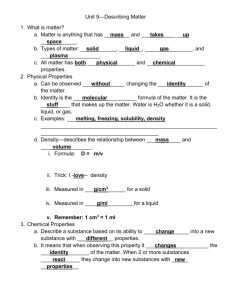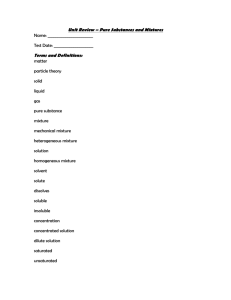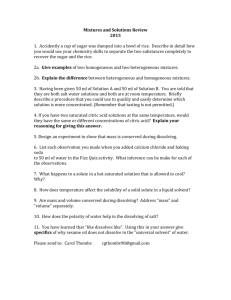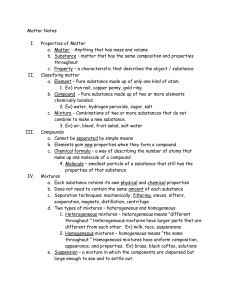Matter Notes
advertisement
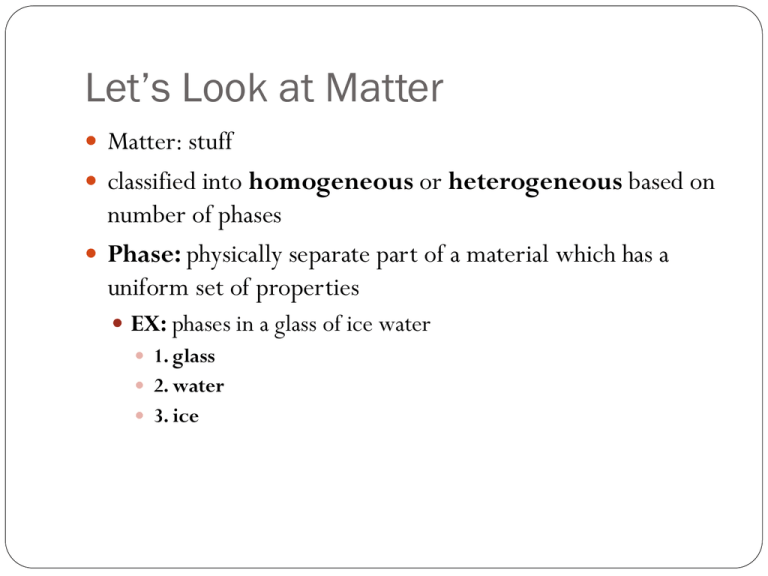
Let’s Look at Matter Matter: stuff classified into homogeneous or heterogeneous based on number of phases Phase: physically separate part of a material which has a uniform set of properties EX: phases in a glass of ice water 1. glass 2. water 3. ice Two Types of Material Heterogeneous: material has more than one phase (granite) Homogeneous: material that only has a single phase (water) Mixtures We often look at how materials combine to form mixtures in Chemistry Mixture: physical combination of two or more different materials. Can be homogeneous or heterogeneous. Heterogeneous matter is always considered a mixture. Homogeneous matter can be a mixture (solution) or a substance (element or compound) Homogeneous Mixtures One type of homogeneous mixture is called a solution. Solutions have two parts Solute: dissolved material(s) Ex: Sugar Solvent: material that the solute dissolves in Ex: Water (universal solvent) The solvent might also be the major component of a solution Liquid Solutions When a solid chemical is mixed with water to create a solution, it has a certain concentration, or molarity. The higher the molarity, the more particles are dissolved in the solution. Molarity can be shown with a large M. Gas Solutions Not all solutions are liquids! Can you think of an example of a gas solution? Air! Air is composed of nitrogen, oxygen, and other gases Depending on where you are from, it can also contain things like soot, pollen Substances Substances: “pure” materials which always have the same composition Example: Pure sulfur or Distilled Water If a substance is composed of one kind of atom, this is what we know as elements. If these elements come together, they form compounds. Always have same composition!! Elements Substances that consist of only one type of atom Cannot be broken down into any simpler substance Exist as atoms or molecules Compounds Can be separated into simpler substances by chemical means Two or more elements in a fixed ratio Chemistry! In Chemistry, we study two types of substances: Organic and Inorganic We primarily look at inorganic substances in this class, but if you go on to other classes, you will learn more organic chemistry. Types of Matter We use the properties of substances to determine the type of matter we are looking at (ex. Color, taste, density, flammability) Each type of matter has two types of properties: Physical and Chemical Physical Properties Characteristics of a substance which can be observed or measured without changing the chemical makeup of a substance Density Size Mass Volume Solubility One major physical property that we looked at in the pop can lab was solubility Solubility: the property of a solid, liquid, or a gas (solute) to dissolve in a solvent Solubility 1. 2. 3. Which substance has the highest solubility? What is the solubility of KCl at 60 degrees Celsius? At what temperature is the solubility of NaCl 40g/100 g water? Chemical Properties How a substance reacts to form a new substance or new substances Based on “reactivity” Does the substance react with other substances? Does it react vigorously? Changes in Matter Matter can go through changes These changes can be either physical or chemical as well Physical Change Chemical Change Do not change the chemical makeup of the changed material (no new substance formed) Result in a new material with a different chemical makeup being formed (new substance formed) Change only the physical properties Change both physical and chemical of a material properties of a material Relatively simple to reverse Very difficult to reverse Look to be fairly simple changes Look more dramatic Not likely to be accompanied by changes in color, temperature, state, or smell Often accompanied by change in color, temperature, state, or smell Pre-Lab Break Down 1. Purpose of the lab -In your own words 2. Materials needed for this lab 3. Steps for the lab -Yes, this includes all parts! - In your own words 4. Pre-lab Questions Pre-lab Questions What is the difference between a physical change and a chemical change? 2. What are four clues that indicate a chemical change? 3. What could happen if HCl or hydrochloric acid comes in contact with your skin? 1.


